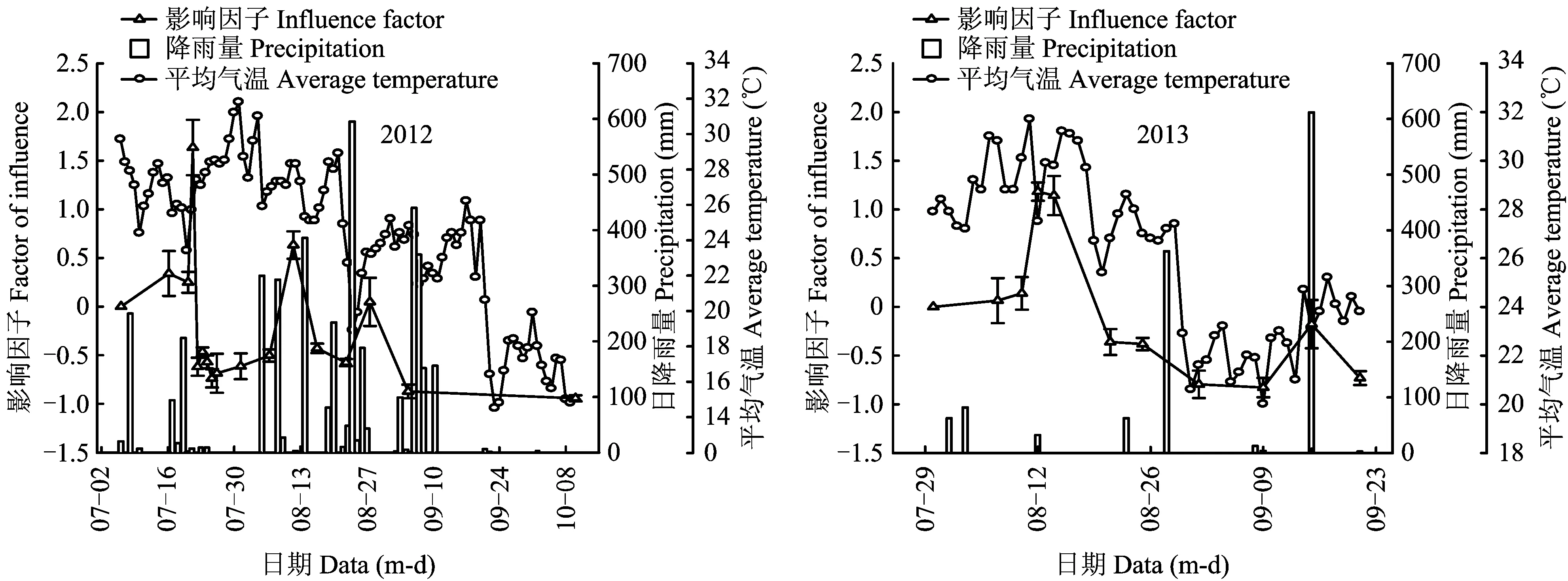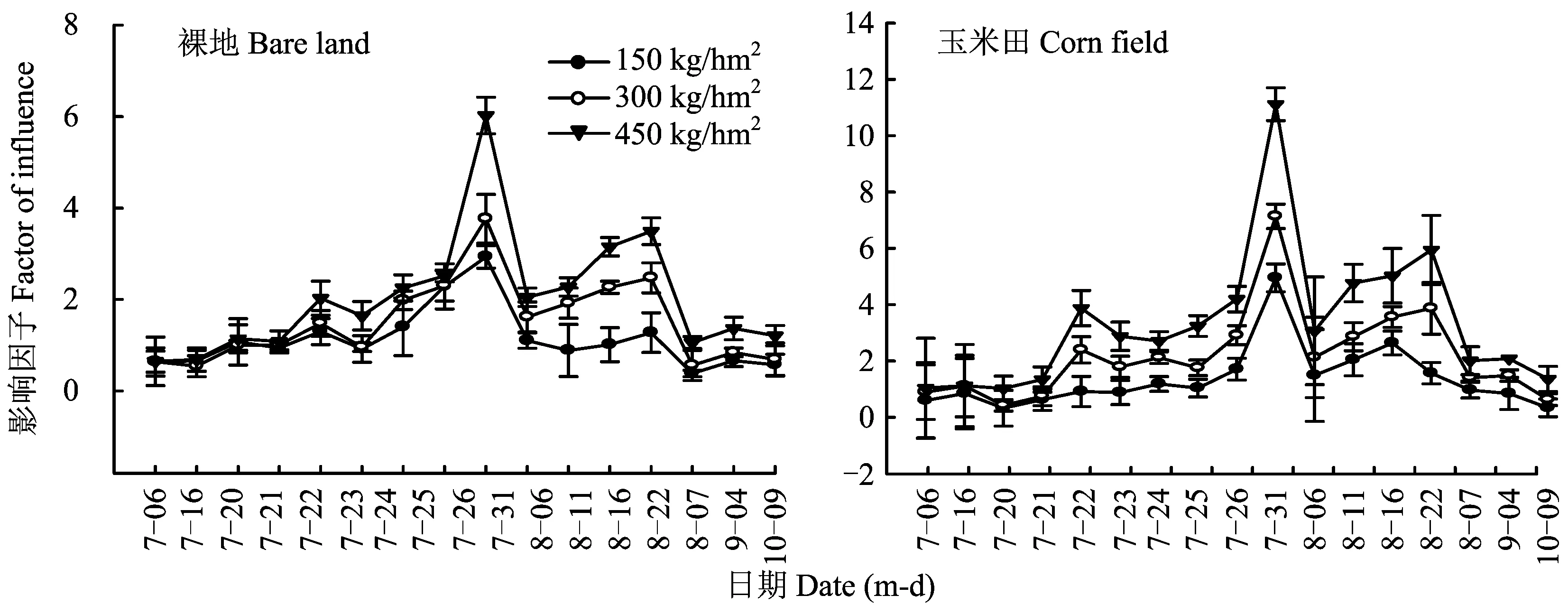夏玉米农田N2O排放影响因素的模拟分析
2016-08-24叶桂香陈国庆
王 良, 徐 旭, 叶桂香, 陈国庆
(作物生物学国家重点实验室, 山东农业大学农学院,山东泰安 271018)
夏玉米农田N2O排放影响因素的模拟分析
王 良, 徐 旭, 叶桂香, 陈国庆*
(作物生物学国家重点实验室, 山东农业大学农学院,山东泰安 271018)

夏玉米农田; 氧化亚氮; 影响因子
N2O不仅是一种重要的温室气体,也是氮肥损失的重要途径之一。N2O排放总量的80%来自农业活动[1-2],明确并量化各影响农田N2O排放因素的影响率及关联,对减少N2O排放及保护生态环境,合理利用氮肥,研究农田氮平衡,以及模拟农田氮运移模型具有重要意义。

本研究通过大田试验模拟单因素变量,采用单因素分析,确定气候、玉米生长吸收以及氮肥对夏玉米农田N2O排放的影响。为作物、肥料和气象因子对农田N2O排放的影响研究提供理论依据,并明确气候、氮肥以及玉米生长吸收对夏玉米农田N2O排放影响率的变化规律。
1 材料与方法
1.1分析方法
夏玉米农田N2O排放主要受气候因素、氮肥管理以及夏玉米生长吸收三个因素的影响,因此N2O排放量可用方程(1)表示:
E=Ebase×(1+fc)×(1+fn)×(1+fp)
(1)
方程(1)中,E为N2O排放量,Ebase为N2O基础排放量,本研究假设在夏玉米播种前农田的排放量为基础排放量。fc为气候条件影响因子,fn为施氮影响因子,fp为夏玉米生长吸收影响因子。
本研究通过分析裸地不施氮肥处理下N2O的排放动态,与基础排放量(某一气候条件下N2O的排放量,本研究选择第一次取样时的气候条件为基础场景)相比较,模拟气候条件对N2O排放的影响因子fc。
(2)
方程(2)中,Ec表示N2O基础排放量,Ec′为不同气候条件下不施氮裸地N2O排放量。Ec′>Ec时,影响因子fc为正,说明该气候条件较基础场景的气候条件利于N2O排放; 否则影响因子为负,该气候条件较基础场景的气候条件抑制N2O排放。
分析不同施氮水平裸地/玉米田N2O排放的差异,模拟施氮对N2O排放的影响因子fn。
(3)
方程(3)中,En为不同施氮水平裸地/玉米田的N2O排放量,En′为相同气候条件下不施氮裸地/玉米田N2O排放量。
分析相同施氮水平条件下裸地与玉米田N2O排放的差异,模拟玉米生长对N2O排放的影响因子fp。
(4)
方程(4)中,Ep为不同施氮水平玉米田N2O排放量,Ep′为同一施氮水平裸地玉米田N2O排放量。Ep′< Ep, 影响因子fp为负,说明夏玉米生长吸收抑制N2O排放。
1.2试验设计
1.3样品采集及数据处理
N2O排放通量采用静态暗箱-气相色谱法测定。静态箱底座(60×50×25 cm3)打入玉米行间土壤中,底座上部设有水槽(取样前倒入水,用于密封),上部箱体(60×50×50 cm3)卡在底座,箱体内
N2O通量计算公式为:
(5)
式中,F为N2O排放通量[mg/(m2·h)]; t为箱内温度; 28为每mol N2O分子中N的质量数; 22.4为温度为273K时的N2O摩尔体积; H为采样箱高度(cm); c为N2O气体浓度(μL/L); t为关箱时间(min); dc/dt为采样箱内N2O气体浓度的变化率[μL/(L·min)]。
试验数据用SPSS软件进行统计分析。
2 结果与分析
2.1气候因子对N2O排放的影响
不施氮肥裸地下2012年和2013年N2O平均排放量分别为0.624和0.504 mg/(m2·h),气候条件的影响因子分别为-0.24和-0.07(图1)。2012年降雨频繁,气候条件对N2O排放的影响较复杂,影响因子出现三次峰值分别为1.64、0.63和0.05。2013年降雨较少,N2O排放主要受温度变化的影响,气候条件对N2O排放影响因子的变化趋势与温度的变化趋势相同,最大影响率为1.18。

图1 2012年和2013年平均气温、降雨量对N2O排放的影响Fig.1 The influence of average temperature, rainfall on the N2O emission rate in 2012 and 2013
2.2氮肥对N2O排放的影响
施氮水平由0提高到450 kg/hm2,N2O排放显著增大,氮肥的影响因子与施氮量存在一定的线性关系(图2)。施氮量150、300和450 kg/hm2时,施氮对裸地N2O排放的平均影响因子分别是0.49、0.72、1.07,对玉米田N2O排放的平均影响因子分别是0.38、1.63、3.54。追肥后施氮对N2O排放的影响最为显著,对裸地N2O排放的影响因子分别为1.93、2.76、5.03,对玉米田的影响因子分别为3.95、6.13、10.12。

图2 2012年不同施氮量裸地和玉米田N2O排放Fig.2 N2O emission in the bare land and corn field under different N application rate in 2012
2.3夏玉米生长对N2O排放的影响率
夏玉米生长吸收对农田N2O排放的平均影响因子为-0.33±0.01,即夏玉米生长吸收降低了N2O的排放量。随着夏玉米生长发育成熟,对N2O排放的影响逐渐减小。在苗期、穗期、花粒期,夏玉米生长吸收对N2O排放的影响率分别为-0.57±0.01、-0.29±0.05和-0.13±0.06,不同生育期间差异显著(P<0.05)。灌水后短时间内,夏玉米生长吸收对N2O排放的影响减小,甚至促进N2O的排放(图3)。

图3 2012年和 2013年夏玉米生长对N2O排放的影响Fig.3 The influence of summer corn growth on N2O emission in 2012 and 2013
2.4影响因素比较分析
2012年与2013年气候条件不同,相同施氮量条件下气候条件对N2O排放的影响存在明显差异。表1表明,施氮量≤150 kg/hm2时,2012年玉米生长吸收的影响因子最大,而2013年气候条件的影响因子最大; 施氮量≥300 kg/hm2时,2012年和2013年施氮的影响因子均为最大。而同一施氮水平2012年与2013年施氮和玉米生长吸收对N2O排放的影响一致。随着施氮量的增加,施氮对N2O排放的影响因子显著增大; 玉米生长吸收对N2O排放的影响因子逐渐减小。因此,高施氮量时(施氮量≤300 kg/hm2),氮肥因素比气候和玉米生长吸收因素的影响大,促进了N2O的排放。低施氮量时(施氮量≤150 kg/hm2),气候因素和玉米生长吸收因素均对N2O排放产生负影响,且随着施氮量的增加影响因子增大,即负影响减小。

表1 不同施氮量下气候条件、施氮、玉米生长吸收对玉米田N2O排放量的影响率
3 讨论
土壤中N2O的产生是一个复杂的物理、化学和生物学过程[17],所有影响这一复杂物理、化学和生物学过程的因素均影响土壤N2O的排放量。气候条件的变化一定程度上决定土壤温度、含水量的变化[3]。一般认为N2O排放量与土壤温度相关性较高,土壤N2O排放通量与温度之间呈显著正相关[18-22]。这与本研气候条件影响因子随温度的变化表现出明显差异的研究结果一致,随着温度的升高气候条件对N2O排放的影响因子增大。土壤含水量对N2O产生和排放的影响主要通过影响产生N2O的硝化、反硝化过程以及影响土壤的通气状况,同时进一步影响土壤O2的有效性和N2O由产生部位到大气中的传输[23-26]。因此,N2O的排放不仅与温度有关,与降雨量也有关系。随温度升高,N2O排放速率明显增加; 随土壤含水量的增大,N2O排放速率亦明显加快[27]。土壤温度直接影响土壤中微生物活性和各种化学反应速率,进而影响土壤中N2O的产生和扩散。而土壤含水量对土壤N2O排放的影响较复杂。土壤含水量较低时,土壤处于好氧条件,N2O的产生主要来自于硝化作用; 土壤含水量较高时,硝化、反硝化作用在一定湿度范围内同时进行; 土壤含水量较大甚至接近饱和时,反硝化作用较强,但产生的N2O由于水分填充土壤空隙,向大气传输过程受阻,进一步还原为N2,N2O排放量反而减小[23-25]。温度与降雨的交互影响是气候影响因子规律性不强的根本原因。2012年降雨量较2013年大且频繁,气候条件对N2O综合排放的影响较2013年大,但2012年和2013年夏玉米生长期气温变化趋势相似,气候条件对N2O影响的变化走势较相似,即降雨和温度的共同作用引起气候条件对土壤N2O排放影响的差异,温度效应大于降雨效应。

作物生长吸收消耗土壤溶液中的氮素,直接减小硝化反硝化作用的底物浓度,进而减少N2O的排放[30]; 也能通过将含有N2O的土壤水吸进体内后,通过浓度梯度可将N2O排放到大气中促进N2O的排放[23]; 还能通过根系的呼吸作用和根系分泌的有机质的分解使根区附近O2压降低,造成嫌气环境,促进土壤的反硝化作用和N2O的产生。本研究结果表明,夏玉米生长吸收对农田N2O排放产生负影响,表明夏玉米生长吸收消耗土壤溶液中氮素,减少硝化、反硝化作用底物浓度,抑制硝化、反硝化作用,且其在对农田N2O排放的影响过程中占主导地位。夏玉米植株在生长发育过程中,在不同生育时期对土壤氮素需求不同,吸收消耗土壤氮素量不同,对土壤N2O排放的影响也因此有所差异。夏玉米生长吸收对农田N2O排放的影响因子在苗期、穗期、花粒期差异显著,而同一时期内的影响因子小范围的波动。
气候条件、施氮和夏玉米生长吸收三因素之间交互影响,气候条件影响施入土壤氮肥的转化; 夏玉米植株的吸氮量在一定程度上与施氮量密切相关[31]; 气候变化也与夏玉米的生长发育密切相关。温度、降雨等气候条件通过影响土壤水、热状况,直接影响N2O的排放,同时还会影响尿素在土壤中的转化[29],间接影响土壤中硝化、反硝化作用底物浓度,最终影响N2O的排放。温度、含水量和底物浓度均直接影响硝化、反硝化作用[32-33],影响N2O的产生。本研究也发现,不同气候条件下随着施氮量的增加,气候条件对N2O排放的影响存在差异,且相同气候条件下不随施氮量的增加显著增大。对于气候条件与氮肥管理因素在影响夏玉米农田N2O排放过程中的交互作用,在模型计算中一般采用乘积法。本研究发现随着施氮量的增加玉米植株生长吸收对N2O排放的影响减小,这又一次说明了施氮因素与夏玉米生长吸收因素在夏玉米农田N2O排放过程中的交互作用。一方面由于施氮量的增加为硝化、反硝化作用提供充足的底物,另一方面由于玉米植株吸氮不与施氮量呈显著线性相关关系,低施氮量时,随着施氮量的增加夏玉米植株的吸氮量明显增加; 施氮量继续增加时,植株吸氮量大幅度增加; 而施氮过量时,植株吸氮量增加减小,但土壤中氮累积量始终随施氮量的增加而增大[34-36]。而夏玉米植株对氮素的吸收又影响了氮素在土壤中的分布。
4 结论
气候条件对N2O排放的影响因子与气温和降雨量密切相关,温度升高影响增大,反之则减小,降雨后排放显著增大。施氮对N2O排放的影响因子随施氮量增加线性增加(R2=0.923)。夏玉米生长吸收降低了N2O排放,不同生育期的影响因子差异显著(P=0.0015),在苗期影响最大,花粒期的影响最小。综合各影响因子,低施氮量条件下(N≦150 kg/hm2),气候因素和夏玉米生长吸收因素对N2O排放的影响较大; 而高施氮量条件下(N≧300 kg/hm2),施氮是影响N2O排放的主要因子,促进了N2O的排放。
[1]IPCC, Working Group III. Greenhouse gas mitigation in agriculture[R]. Fourth Assessment Report, 2006.
[2]IPCC. 2006 IPCC guidelines for national greenhouse gas inventories[M]. IPCC/IGES, Havana, Japan, 2006.
[3]蔡延江, 丁维新, 项 剑, 等. 农田土壤N2O和NO排放的影响因素及其作用机制[J]. 土壤, 2012, 44(6): 881-887.
Cai Y J, Ding W X, Xing J,etal. Factors controlling N2O and NO emissions from agricultural soils and their influencing mechanisms: A review[J]. Soils, 2012, 44(6): 881-887.
[4]Mosier A R, Halvorson A D, Reule C A,etal. Net globalwarming potential and greenhouse gas intensity in irrigated cropping systems in northeastern Colorado[J]. Journal of Environmental Quality, 2006, 35(4): 1584-1598.
[5]Halvorson A D, Grosso S J D, Reule C A. Nitrogen, tillage, and crop rotation effects on nitrous oxide emissions from irrigated cropping systems[J]. Journal of Environmental Quality, 2008, 37(4): 1337-1344.
[6]Mcswiney C P, Robertson G P. Nonlinear response of N2O flux to incremental fertilizer addition in a continuous maize (ZeamaysL.) cropping system[J]. Global Change Biology, 2005, 11(10): 1712-1719.
[7]Grant R F, Pattey E, Goddard T W,etal. Modeling the effects of fertilizer application rate on nitrous oxide emissions[J]. Soil Science Society of America Journal, 2006, 70(1): 235-248.
[8]武其甫, 武雪萍, 李银坤.等. 保护地土壤N2O排放通量特征研究[J]. 植物营养与肥料学报, 2011, 17(4): 942-948.
Wu Q F, Wu X P, Li Y K,etal. Studies on the fluxes of nitrous oxide from greenhouse vegetable soil[J]. Plant Nutrition and Fertilizer Science, 2011, 17(4): 942-948.
[9]陈书涛, 黄耀, 郑循华, 等. 种植不同作物对农田N2O和CH4排放的影响及其驱动因子[J]. 气候与环境研究, 2007, 12(2): 148-155.
Chen S T, Huang Y, Zheng X H,etal. Nitrous oxide and methane emissions from croplands with different crops and driving factors[J]. Climatic and Environmental Research, 2007, 12(2): 148-155.
[10]Scott S M and Tiedje M J. The effect of roots on soil denitrification[J]. Soil Science Society of America Journal, 1979, 43(5): 951-957.
[11]Philippot L, Kuffner M, Cheneby D,etal. Genetic structure and activity of the nitrate-reducers community in the rhizosphere of different cultivars of maize[J]. Plant and Soil, 2006, 287(1/2): 177-186.
[12]黄国宏, 陈冠雄, 黄斌, 等. 玉米植株对大田温室气体N2O排放的影响[J]. 应用生态学报, 1998, 9(3): 261-264.
Huang G H, Chen G X, Huang B,etal. Effect of maize plant on N2O emission from field[J]. Chinese Journal of Applied Ecology, 1998, 9(3): 261-264.
[13]中华人民共和国国家统计局. 中国统计年鉴[M]. 北京: 中国统计出版社, 2013.
National Bureau of Statistics of the People’s Republic of China. China year book[M]. Beijing: China Statistical Publishing House, 2013.
[14]Ravishankara A R, Daniel J S, Portmann R W. Nitrous oxide (N2O): The dominant ozone-depleting substance emitted in the 21st century[J]. Science, 2009, 326(5949): 123-134.
[15]万运帆, 李玉娥, 林而达, 等. 静态箱法测定旱地农田温室气体时密闭时间的研究[J]. 中国农业气象, 2005, 27(2): 122-124.
Wan Y F, Li Y E, Lin E D,etal. Studies on closing time in measuring greenhouse gas emission from dry cropland by static chamber method[J]. Chinese Journal of AgroMeteorology, 2005, 27(2): 122-124.
[16]田慎重, 宁堂原, 迟淑筠,等. 不同耕作措施的温室气体排放日变化及最佳观测时间[J]. 生态学报,2012, 32(3): 879-888.
Tian S Z, Ning T Y, Chi S J,etal. Diurnal variations of the greenhouse gases emission and their optimal observation duration under different tillage systems[J]. Acta Ecologica Sinica, 2012, 32(3): 879-888.
[17]Parton W J, Mosier A R, Ojima D S,etal. Generalized model for N2and N2O production from nitrification and denitrification[J]. Global Biogeochemical Cycles, 1996, 10(3): 401-412.
[18]Conrad R, Seiler W, Bunse G. Factors influencing the loss of fertilizer nitrogen into the atmosphere as nitrous oxide[J]. Journal of Geophysical Research-Atmospheres, 1983, 88: 6709-6718.
[19]张小洪, 袁红梅, 蒋文举, 等. 油菜地CO2、N2O排放及其影响因素[J]. 生态与农村环境学报, 2007, 23(3): 5-8.
Zhang X H, Yuan H M, Jiang W J,etal. CO2and N2O emission from the rape field and their controlling factors[J]. Journal of Ecology and Rural Environment, 2007, 23(3): 5-8.
[20]Zheng X H, Huang Y, Wang Y S,etal. Effects of soil temperatureon nitrous oxide emission from a typical Chinese rice-wheat rotation during the non-waterlogged period[J]. Global Change Biology, 2003, 9: 601-611.
[21]陈卫卫, 张友民, 王毅勇, 等. 三江平原稻田N2O通量特征[J]. 农业环境科学学报, 2007, 26(1): 364-368.
Chen W W, Zhang Y M, Wang Y Y,etal. Characteristics of N2O fluxes in paddy fields of the Sanjiang Plain[J]. Journal of Agro-Environment Science, 2007, 26(1): 364-368.
[22]Jiang C S, Wang Y, Zhang X H,etal. Methane and nitrous oxide emissions from three paddy rice based cultivation systems in southwest China[J]. Advances in Atmospheric Sciences, 2006, 23(3): 415-424
[23]李香兰, 徐华, 蔡祖聪, 等. 水分管理影响稻田氧化亚氮排放研究进展[J]. 土壤, 2009, 41 (1): 1-7.
Li X L, Xu H, Cai Z C,etal. Effect of water management on nitrous oxide emission from rice paddy field: A review[J]. Soils, 2009, 41(1): 1-7.
[24]Novoa R, Tejeda H R. Evaluation of the N2O emissions from N in plant residues as affected by environmental and management factors[J]. Nutrient Cycling in Agroecosystems, 2006, 75: 23-29.[25]Malhi S S, Mcgill W B. Nitrification in three Alberta soils: Effect of temperature, moisture and substrate concentration[J]. Soil Biology & Biochemistry, 1982, 14: 393-399.
[26]Harada T, Kai H. Studies on the environmental conditionscontrolling nitrification in soils. I. Effects of ammonium and total salts in media on the rate of nitrification[J]. Soil Science and Plant Nutrition, 1968, 14: 20-26.


[28]宋长春, 张丽华, 王毅勇, 赵志春. 淡水沼泽湿地CO2、CH4和N2O排放通量年际变化及其对氮输入的响应[J]. 环境科学, 2006, 27(12): 2369-2375.
Song C C, Zhang L H, Wang Y Y, Zhao Z C. Annual dynamics of CO2, CH4, N2O emissions from freshwater marshes and affected by nitrogen fertilization[J]. Environmental Science, 2006, 27(12): 2369-2375.
[29]Skiba U, Wain wright M. Urea hydrolysis and transformations in coastal dune sands soil[J]. Plant and Soil, 1984, 82 (1): 117-123.
[30]杨思河, 陈冠雄, 林继惠, 等. 几种木本植物的N2O释放与某些生理活动的关系[J]. 应用生态学报 1995, 6(4): 337-340.
Yang S H, Chen G X, Lin J H,etal. N2O emission from woody plants and its relation to their physiological activities[J]. Chinese Journal of Applied Ecology, 1995, 6(4): 337-340.
[31]Du H X, W P T, Feng H,etal. Influence of nitrogen applicationon soil moisture-nitrogen dynamics and water-fertilizer use efficiency ofZeamays[J]. Science of Soil and Water Conservation, 2009, 7(4): 82-87.
[32]Barnard R, Leadley P W, Hungate B A. Global change, nitrification,and de-nitrification: A review[M]. Global Biogeochemical Cycles, 2005, 19(1).
[33]Dobbie K E, Smith K A. The effects of temperature, water-filled pore space and land use on N2O emissions from an imperfectly drained gleysol[J]. European Journal of Soil Science, 2001, 52(4): 667-673.
[34]Bergstrom L, Brink N. Effects of differentiated applications offertilizer N leaching losses and distribution of inorganic N in soil[J]. Plant and Soil, 1986, 93(3): 333-345.
[35]Liang B C, Mackenzie A F. Changes of soil nitrate-nitrogen and de-nitrification as affected by nitrogen fertilizer on two Quebec soil[J]. Journal of Environmental Quality, 1994, 23(3): 521-525.[36]范丙全, 胡春芳, 平建立. 灌溉施肥对壤质潮土硝态氮淋溶的影响[J]. 植物营养与肥料学报, 1998, 4(1): 16-21.
Fan B Q, Hu C F, Ping J L. Effect of irrigation and fertilization on nitrate leaching in loamy fluvo-aguic soil[J]. Plant Nutrition and Fertilizer Science, 1998, 4(1): 16-21.
Simulation of the factors influencing N2O emission in summer corn farmland
WANG Liang, XU Xu, YE Gui-xiang, CHEN Guo-qing*
(StateKeyLaboratoryofCropBiology/AgronomyCollege,ShandongAgriculturalUniversity,Tai’an,Shandong271018,China)
【Objectives】 Agricultural soils are considered as a major source of N2O emission contributing approximately 46%-52% of the global anthropogenic N2O flux. We analyzed the contribution of climate factors, nitrogen (N) fertilizer application rates and the absorption of summer corn on N2O emission from soil in summer corn field which had great importance to reduce N2O emissions produced by N fertilizer.【Methods】Split plot field experiments were conducted in summer corn in 2012 and 2013. The main factor was summer corn and fallow field, the deputy factor was nitrogen application rates (N 0, 150, 300, 450 kg/hm2). N2O emission rate was determined using static chamber technology combined with gas chromatography in different treatments. The contribution of temperature, precipitation, nitrogen managements and the absorption of summer corn on N2O emission was calculated.【Results】 The influence of meteorological conditions on the N2O emission was significant. The impact factors of temperature and precipitation on the N2O emission were -0.24 and -0.07 in 2012 and 2013, respectively. Nitrogen fertilization increased N2O emission which followed a linear relationship with the increase of N application rate (R2= 0.923). The effect of nitrogen application on N2O emission was 0, 0.38, 1.63 and 3.54 when the N application rate was 0, 150, 300 and 450 kg/hm2, respectively. The average impact factor of summer corn growth on the N2O emission was -0.33, which did not differ between 2012 and 2013 (P= 0.07). At seedling stage, ear period and grain stage, the effect of summer corn growth on the N2O emission was -0.57, -0.29 and -0.13, respectively, and had significant difference between growing stages (P=0.0015). Climatic condition had no significant effect on N2O emission on summer corn field under different nitrogen application rates (P> 0.05). With the different climates in years, there was no significant effect of summer corn growth on the N2O emission with different temperature and precipitation under the same nitrogen application rate (P> 0.05).【Conclusions】 Higher temperature and precipitation greatly stimulate N2O. High nitrogen fertilization application leads to increased N2O emission. Summer corn growth has a negative impact on N2O emission, which varies significantly in different growing stages. Climate and crop absorption are the two main factors influencing N2O emission when the nitrogen application rate is less than 150 kg/hm2, and nitrogen application is the main factor when the nitrogen rate is higher than 300 kg/hm2.
summer corn; farmland; nitrous oxide; impacting factor
2014-12-11接受日期: 2015-10-13网络出版日期: 2015-12-08
国家自然科学基金项目(31101083,31471414)资助。
王良(1988—),男,山东枣庄人,硕士研究生,主要从事农业信息化研究。E-mail: wangliang11.04@163.com
E-mail: gqchen@sdau.edu.cn
S147.2
A
1008-505X(2016)02-0346-07
